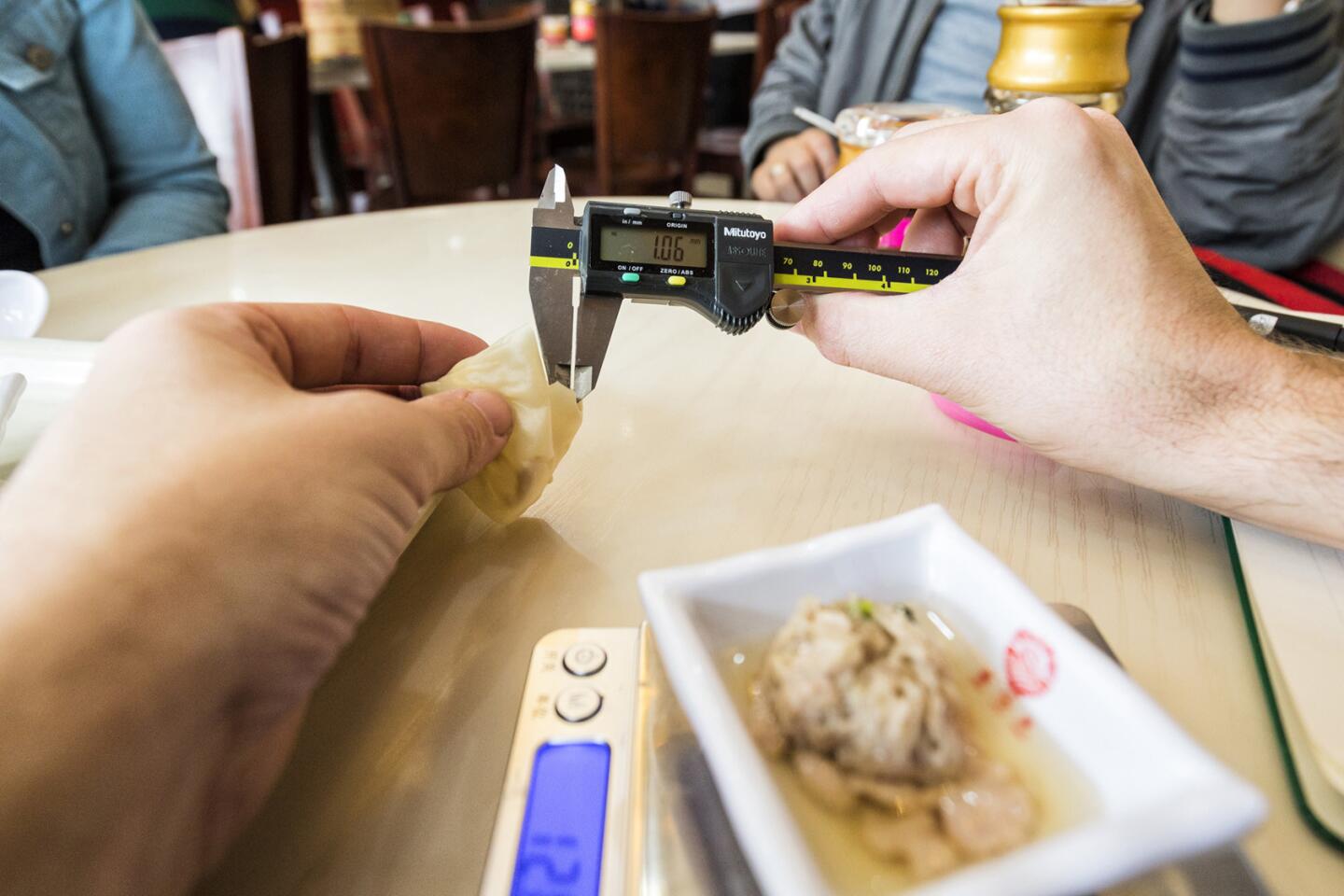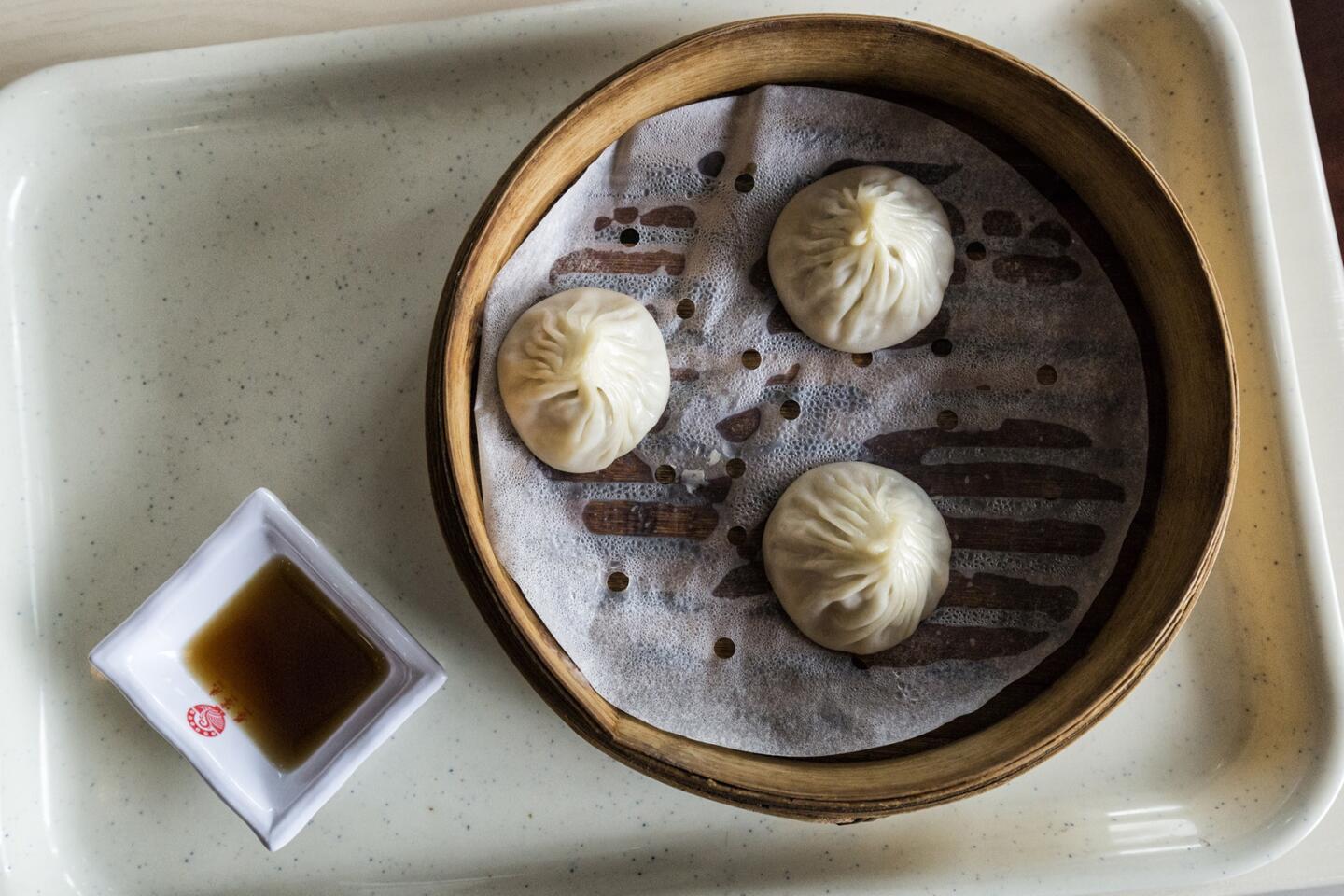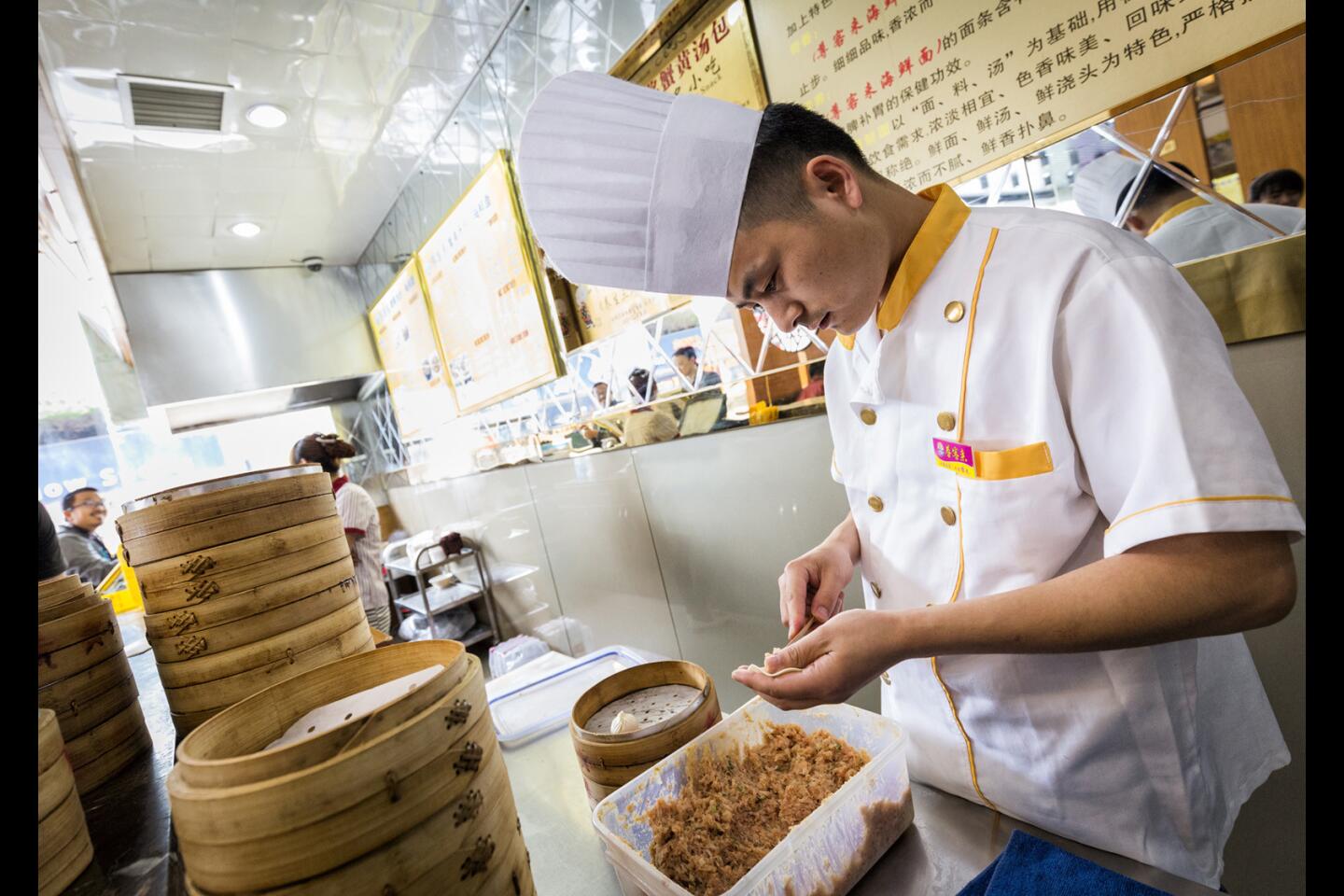Great Read: Shanghai Soup Dumpling Index: The nerdiest food guide ever?
Reporting from Shanghai — Chef-turned-food writer Christopher St. Cavish is striding toward the front door of the Welcome Revered Guests restaurant when he stops dead in his tracks. “They don’t like me here,” he says, frowning.
It’s not that he has panned the eatery. In fact, he gave it his highest rating. Rather, what has annoyed the staff here is the way St. Cavish judges the quintessential Shanghai snack: soup dumplings known as xiao long bao.
On his last visit to Welcome Revered Guests, he ordered nine baskets of the handmade dumplings, then spent the next hour analyzing them like a lab tech, using an electronic scale accurate to 1/100th of a gram, digital calipers capable of measuring 1/100th of a millimeter (Mitutoyo model 500-196-20), and a set of 140-millimeter shearing scissors.
After all his calculations, only two dumplings went down his gullet, while 52 went into a takeout box.
Scientific tools in hand, St. Cavish has probed the thinness of the dough, the volume of the soup and the weight of hundreds upon hundreds of pork meatballs at dozens of restaurants. He has even conducted a time study of how the structure of xiao long bao changes upon leaving the steamer and starting to cool in a bid to determine the ideal window in which to devour the hot little pouches before the skin thickens too much.
The numbers have been crunched into what just may be the nerdiest restaurant guide ever, the Shanghai Soup Dumpling Index. Welcome Revered Guests, or Zun Ke Lai in Mandarin, landed on top.
Xiao long bao — eaten for breakfast, lunch, dinner or even to satisfy the midnight munchies — have become an object of obsession among foodies the world over; the Shanghai government has even listed them as one of 84 “protected traditional treasures” of the city. Debate over who makes the best rages from Shanghai to Hong Kong to Taipei to Southern California, as anyone who has ever queued for hours at the Arcadia branch of Din Tai Fung can attest.
RELATED: Three of Jonathan Gold’s favorite soup dumplings in the L.A. area
St. Cavish, a 34-year-old native of south Florida who worked as a chef in Miami and the Hamptons for a decade before coming to China, is perhaps more qualified than most to attest to the superiority of the dumplings here at Zun Ke Lai. Since late 2013, he has worked his way across this sprawling city of 24 million, paying surprise visits to 52 purveyors of these delicacies on a quest for the ideal xiao long bao.
Some of the staff at Zun Ke Lai, though, have been more irritated than gratified by St. Cavish’s attention.
“They were [angry],” St. Cavish recalls, glancing through the front window to see whether the older woman who had to hand-make his infuriating 54-dumpling order is behind the counter today. “When I later told her Zun Ke Lai came out on top of my index, she was totally unimpressed. She looked at me as if I had just told her I had a toenail problem.”
::
The annoyance of the Zun Ke Lai crew notwithstanding, the Shanghai Soup Dumpling Index is giving St. Cavish 15 minutes of fame in China.
It has been more than 30 years since Harold McGee brought a chemist’s eye to American home kitchens with his 1984 book, “On Food and Cooking,” and in recent years science-inflected cooking shows such as “Good Eats with Alton Brown” have become cable TV staples in the U.S. But St. Cavish’s detailed dissection of dumplings has been greeted as something of a revelation in China, where food is generally regarded as art, not science.
News outlets across China have reported on the index, which St. Cavish has published in the form of a bilingual, scientific-looking foldable chart (cost: $8), featuring tongue-in-cheek academically pompous text alongside wonky triangle diagrams illustrating the proportion of filling to skin, the thickness of the pastry and deviation from average weight. The Guangzhou Daily has praised the “foreigner’s meticulousness and standards, which can increase efficiency and accuracy. We should all learn from it.”
The paper lauded his willpower to persevere, despite disapproving reactions from both restaurant workers and customers.
“His success is not only the invention of the formula to analyze the taste of xiao long bao; more importantly, he did what he wanted to do, he achieved his dreams through willpower, persistency and dedication, and the ignorance of ‘saving face,’” the Daily said.
Before coming to China, St. Cavish said, he didn’t have any particular background in science and he had never even eaten a xiao long bao. And even today, he says they’re not his favorite dish, and he doesn’t cook them at home.
“I’m not obsessed with them,” he says, pushing his thick black-framed glasses up the bridge of his nose. “But they happen to be a vehicle for lots of other ideas I have about food and food writing.”
St. Cavish says part of his motivation was to find a “data-based defense” of Din Tai Fung dumplings, to which he’s long been partial, yet are frowned upon by some Shanghai locals as the inferior product of a Taiwan-based interloper. (Din Tai Fung, which has outlets the world over, including Shanghai, is known for its strict adherence to its recipe, and its standard 18 pleats in the dough — not one more, not one less.)
The defend-Din Tai Fung impetus was “petty,” but another, more lofty, aim, St. Cavish says, is to find a new way to talk about food.
“All my previous writing about food was very subjective,” says St. Cavish, who came to Shanghai in 2005 to cook at the Shangri-La hotel and later turned to writing, doing articles for local English-language magazines, copy-editing for a real estate company and giving the occasional food tour. “It was liberating to go to a restaurant and not think: Do I like this or not like it, why or why not?”
::
Unlike other iconic Shanghainese dishes, xiao long bao proved the optimal subject for a numbers-based experiment, St. Cavish says, because three of the four standards for a well-constructed soup dumpling — thin skin, plentiful soup and abundant filling — can be easily measured and expressed in a mathematical formula.
“There’s not a lot of foods like that. A croissant has just three ingredients — butter, flour and salt — but assessing flakiness is really hard,” he says by way of example.
The index is essentially mute on the fourth xiao long bao standard, savory meat. Attempting to measure that, St. Cavish writes in the pamphlet, “would have required analysis by potentiometric solid-state electrodes or near infrared-spectroscopy, both beyond the means of the researcher,” though he did disqualify any dumpling with an excessive taste of MSG.
Mao Fuyu, the manager of Zun Ke Lai, agrees with St. Cavish that “taste is very hard to rank. If you have 100 people, they have 100 different opinions; some like it sweet, some spicy. But soup and skin are the critical factors.”
Asked how Zun Ke Lai manages to make its skins so thin — an average of 0.72 millimeters — and its filling so heavy (46% by weight), Mao replies, “That’s a trade secret.”
St. Cavish divides his 52 surveyed restaurants into Class A (a score of 12 or above), B (6.75 or above) and C (below 6.75 — “to be avoided”). Most Class A dumplings, he discovered, were at least 20% soup by weight. None had a skin thicker than 1.36 millimeters. Din Tai Fung ranked No. 7 on the index with a score of 13.86; Zun Ke Lai’s 10-cent-apiece dumplings topped the charts with a 24.32 mark.
Anthony Zhao, who serves the dumplings at his two Shanghai restaurants, says the popularity of Din Tai Fung’s pricey dumplings — nearly $1 each here — has captured the attention of Shanghai chefs, who are now experimenting with colored skins and unconventional fillings.
“Chefs are looking at more mid- to high-range versions, catering to the nouveau riche,” he says.
Crystyl Mo, a Shanghai-based food writer and correspondent for Travel + Leisure magazine, calls the index “an interesting way to assess the quintessential Shanghai food.”
“I don’t know if the most delicious xiao long bao wins; maybe it’s the most technically perfect one,” she says. “But people always love talking about xiao long bao, and this keeps the conversation going.”
St. Cavish freely admits that on one hand, the index is a “ridiculous project.”
“It’s a funny experiment; I don’t want people to take it too seriously,” he says, sitting in a booth at Zun Ke Lai, his measuring paraphernalia and three baskets of dumplings in front of him. “I’m not implying that people should only cook by scales or measurements … of course the human factor is very important.”
But at the same time, he says, the index gives restaurant-goers — and himself — a way to think more deeply and talk more precisely about the architecture behind what makes a food satisfying or even delicious.
“As a food writer, your responsibility is to explain why you like or don’t like something,” he says. “I’m not sure if xiao long bao has benefited from this analysis, but I’ve benefited.”
Tommy Yang and Nicole Liu of The Times’ Beijing bureau contributed to this report.
More to Read
Sign up for Essential California
The most important California stories and recommendations in your inbox every morning.
You may occasionally receive promotional content from the Los Angeles Times.















